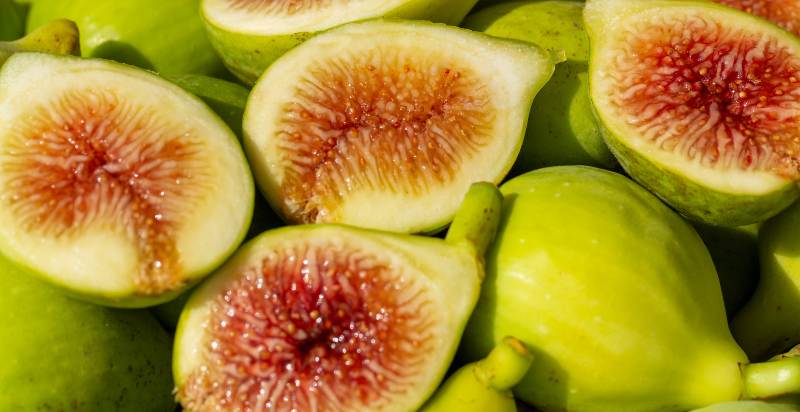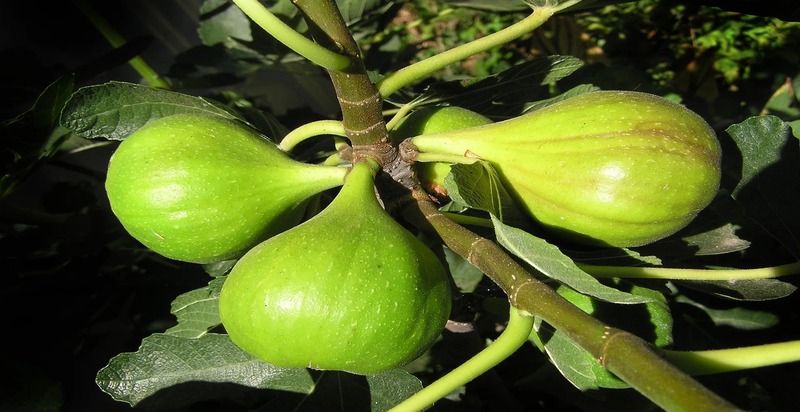Green figs, scientifically known as Ficus carica, are a popular fruit enjoyed around the world. They can be consumed in various forms, such as fresh, canned, preserved, dried, or frozen, to cater to diverse culinary preferences. These small yet flavorful fruits are not only known for their distinct taste but also for their numerous health benefits, making them a valuable inclusion in any diet. This article aims to provide insight into the world of green figs, including their nutritional value, the multiple health benefits they offer, and creative ways to incorporate them into recipes. Whether you’re a long-time fig enthusiast or new to their unique flavor profile, get ready to explore the rich tapestry of benefits and uses that Ficus carica brings to the table.
What are Green Figs?
Green figs are the unripe fruit of the ficus tree. They have a green, waxy outer layer and a soft texture. The flesh of green figs is pale yellow and has a sweet and mild taste. As they mature, they turn to a brownish-black color and become much sweeter. Green figs are commonly eaten fresh or used for making jams, jellies, and preserves.
The leaves of the ficus tree can be used to make teas and infusions. In various cultures, green figs are regarded as a delicacy and are served as a side dish or as part of the main course. Additionally, they are used in traditional medicines for their supposed health benefits. The seeds of the ficus tree can be dried and used as a natural sweetener or pressed into oil for cooking purposes.

History and Origin of Green Figs
Green figs, which are native to the Middle East, Africa, and India, have a significant place in the history of agriculture and traditional medicine. They were one of the first fruits to be domesticated over 6,000 years ago, and their early cultivation, confirmed by archaeological evidence, highlights their importance in ancient diets and early agricultural development. The fig tree is very versatile and can thrive in various climates and terrains, making it easy to spread among ancient civilizations. The sweet and nutritious fruit of the fig tree was highly prized, and its medicinal properties were also valued. Green figs were used in traditional remedies to treat a variety of ailments, ranging from digestive issues to skin conditions, and they were known for their anti-inflammatory and antioxidant benefits. This combination of nutritional value and healing properties made green figs an essential component of ancient wellness practices, reflecting the close relationship between humans and nature in seeking nourishment and healing. It also highlights the enduring legacy of green figs in cultural and medicinal traditions across these storied regions.
During the late 15th century, Spanish explorers introduced green figs to the Americas. Over time, the fruit gained popularity and became a common household item. Nowadays, green figs are grown in warm climates globally for commercial purposes.
Description of Green Figs
Green figs are small to medium-sized fruits measuring between 4 and 8 cm long. They have a pear-like shape with waxy, thin skin that can range in color from light green to yellow. The interior of a green fig contains many tiny edible seeds with a sweet and slightly tart flavor. The texture of green figs is similar to a ripe pear, with a soft flesh that easily breaks apart when eaten.
Flavor Profile of Green Figs
Green figs have a uniquely sweet, honey-like flavor distinct from other figs. The ripeness of the fruit can affect the flavor as well, with more ripe figs being sweeter and softer than less ripe ones. When eaten fresh, the texture of a green fig is succulent and juicy, with dense flesh and slightly crisp skin.
Green figs are often used in desserts, such as cakes or tarts, as their sweetness complements the other ingredients. They can also be used in savory dishes like salads, sauces or even cooked down into a jam or compote.
Seasonality and Availability throughout the year of Green Figs
Green figs are available throughout the year, although they peak in late summer and early autumn. Depending on the variety of the fruit, it can be found in different parts of the world. In Europe, green figs are available from June to October.
In North America, they are typically found from August to October. In Asia, the fruit is available from July to October. The peak season for green figs in the Middle East and North Africa is August to October. Green figs have a unique taste and can be eaten raw or cooked in various dishes.
Health Benefits of Green Figs
Green figs are a good source of dietary fiber, which helps keep your digestive system healthy and regular. They are also rich in Vitamin C, making them a great addition to any healthy diet. In addition, green figs contain small amounts of manganese, which is necessary for properly functioning enzymes that help regulate blood sugar levels.
Green figs are also a good calcium, iron, and potassium source. These minerals help keep your bones and teeth strong and regulate your electrolytes. Furthermore, green figs contain polyphenols which act as antioxidants to protect our cells from damage caused by free radicals. Finally, they have been found to have antibacterial properties, which can help reduce the risk of infection.

Cultivation of the Green Figs
Green figs can be cultivated through seeds which is the most common method. Seeds are sown directly into the soil and should be planted at least 2-3 inches deep as it helps in faster germination. Once the seedlings emerge, they should be thinned out to about 10-12 inches apart so that each tree has enough space to grow without competition. The soil should always be kept moist, and organic fertilizers like cow dung or compost manure can provide additional nutrients to the plant.
It is important to water the tree regularly, especially during dry spells. Branch pruning helps control the tree’s size and shape for better yield. Figs require full sunlight to thrive, so they should be planted in an open, sunny area.
Harvesting of the Green Figs
The trees’ branches have been pruned, and the fully-ripe green figs have been collected in bags for transportation. The figs are then classified according to their size and ripeness. In certain traditional communities, a special curved knife called a “career” is employed for harvesting figs. Once collected, the figs are weighed, washed, and graded for sale in the local markets or export purposes.
Where Do Green Figs Grow?
Green figs are a well-known fruit that is grown and eaten in various regions across the globe, such as Asia, Africa, the Caribbean, South America, North America, and Europe. In India and Pakistan, green figs are especially popular, while in Morocco and some parts of Niger and Sudan, they are also widely consumed. The Caribbean islands are a major producer of green figs, and Jamaica is the largest producer among them.
Green figs are a popular fruit grown in various regions of the world. In South America, they are cultivated in countries like Brazil, Peru, and Colombia. North America also has many regions where green figs grow, including Mexico, Florida, and California. In Europe, they are mostly found in Mediterranean countries such as Spain, Italy, and Greece.

What are the things to remember when Buying Green Figs?
When purchasing green figs, it is crucial to ensure their freshness. Opt for plump and firm figs with smooth skins, devoid of any blemishes or marks. Avoid any figs that appear overly soft or shriveled. It is also essential to select figs of varying sizes, if possible, to achieve the best texture and flavor while cooking. Selecting ripe but unripe figs is also crucial, as overripe fruits can quickly become mushy and unpleasant. Lastly, store all figs in the refrigerator until you can use them to preserve their freshness and prevent spoilage.
When you are planning to buy green figs, it is always advisable to purchase them from a trustworthy vendor. Look for a store or a market that offers high-quality products and inspect each fig before you take it home. Moreover, you should check the labels on any packaged figs and try to select organic or sustainably grown varieties if they are available. Finally, if you are not planning to use the figs right away, make sure to store them in a cool, dry place away from direct sunlight. Doing so will help maintain their flavor and texture for an extended period.
What is the best way to store Green Figs?
The best way to store green figs is to wrap them in a plastic bag or container and keep them in the refrigerator. This method can store green figs for up to two weeks. If you want to store them for longer, it is recommended that you freeze them in an airtight container. Frozen figs can last up to six months if stored properly.
If you need to keep your figs at room temperature, they should be stored in a cool, dark place for no more than a few days. Overripe figs can be pureed and frozen for up to one year. It is also important to avoid washing figs until just before eating them, as this can cause them to spoil faster. When preparing green figs for eating, it is best to cut away any soft or discolored spots.
How can Green Figs be used in recipes with other Fruits and Vegetables?
Green figs can be used in various recipes incorporating other fruits and vegetables. Figs are delicious when paired with apples and pears and root vegetables such as carrots, sweet potatoes, and onions. Figs can also pair nicely with nuts and seeds like walnuts, pistachios, and sesame seeds. Figs can make great additions to salads and an accompaniment to savory dishes like grilled meats and fish.
Figs can also be cooked down into compotes and jams or pureed into sauces and dressings for a delicious addition to any dish. With so many ways to use green figs, they will become a regular part of your culinary repertoire. Try incorporating them into your favorite recipes today, and you won’t be disappointed.
Conclusion
Green figs are a nutritious and delicious addition to any meal. With the proper storage techniques, they can be kept for up to two weeks in the refrigerator or six months in the freezer. Figs also make a great addition to salads, meals, compotes, jams, sauces, and dressings. There are so many ways to incorporate green figs into your favorite recipes, so why not give them a try today?
- Fuerte Avocado: History, Flavor, Calories, Benefits, And Uses - March 27, 2024
- Everything You Wanted to Know About Barhi Dates - March 23, 2024
- Everything You Wanted To Know About Beech Mushrooms - March 23, 2024

1 thought on “Green Figs: Description, Flavor, Benefits, And Uses”
Comments are closed.